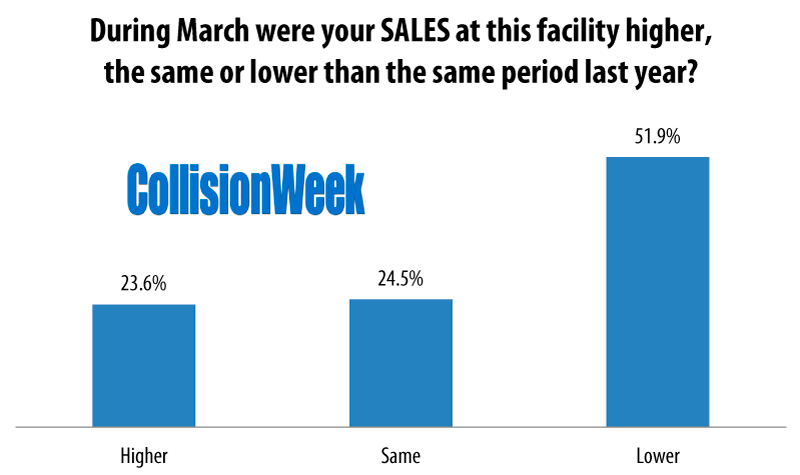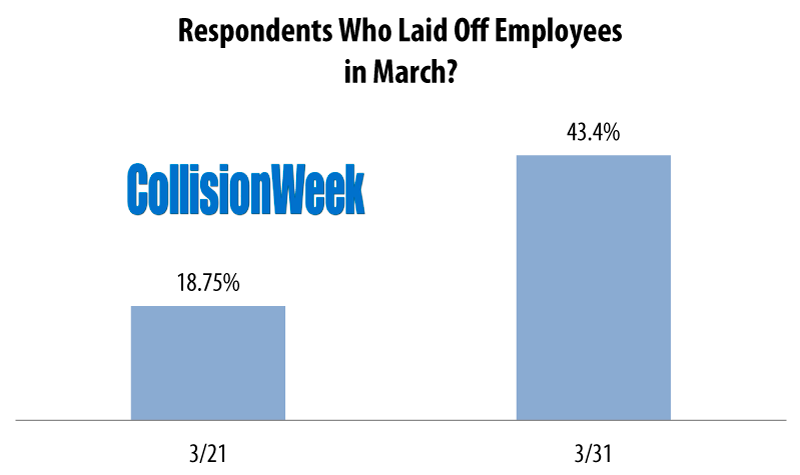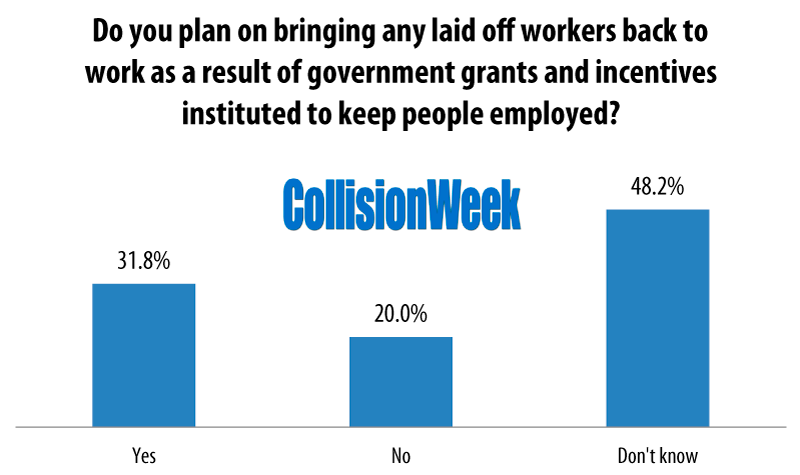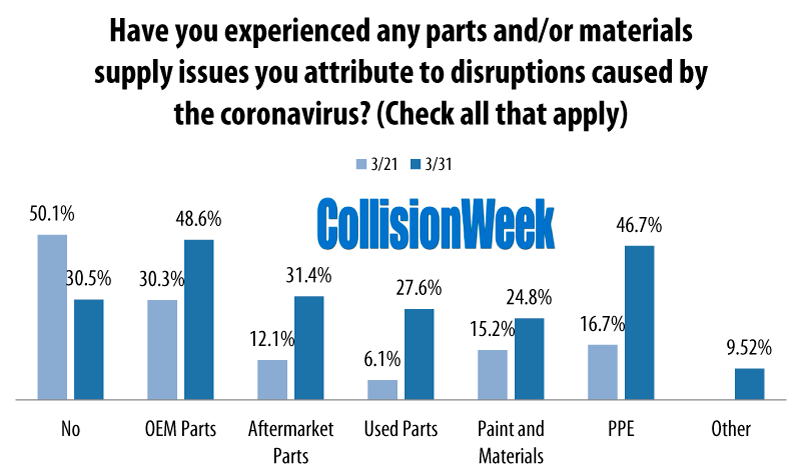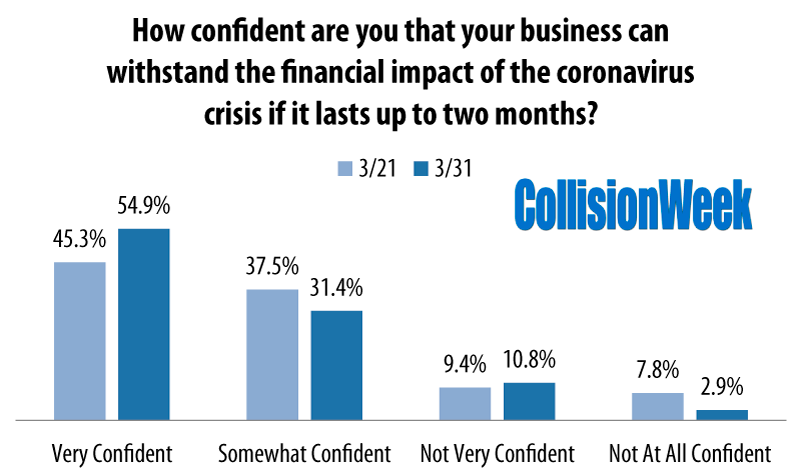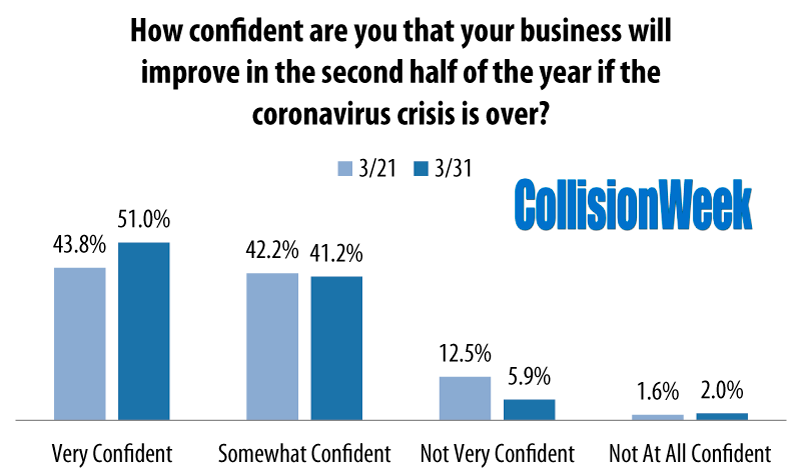Collision repair facilities remain open but business has slowed dramatically in the second half of the month. Shops more optimistic in most recent study compared to mid-March.
The vast majority of collision repair facilities responding to a CollisionWeek study last week were open, but have seen more slowdowns at the end of March versus mid-month due to coronavirus response. Operator sentiment on their business survival and sales improvement in the second half of 2020 has improved in the most recent study.
Research conducted by CollisionWeek across U.S. collision repair facilities on April 2-3 shows collision repair centers have remained open in the face of the coronavirus response and are more optimistic about the future of their business and growth after the crisis ends.
In the most recent study, 90.4 percent of respondents reported their facilities were now under shelter-in-place or non-essential business closure restrictions, up from 48.8 percent in our March 19-20 survey.
Fully 93.6% of respondents reported their facilities were open, down from the 100% of respondents indicating they remained open in the mid-March study.
As our earlier study had indicated, business had been fairly robust so far this year for respondents to the study with over three-quarters of respondents reporting the same or higher sales during January and February compared to 2019. When they were asked at that time if business had declined since the governmental actions and public concerns over the coronavirus took hold during March, 78.8% of respondents said that sales had declined. Just 9% of respondents said no, and 12.1% were not sure of the impact.
When asked about their sales for the full month of March in our most recent study, 51.9 percent reported lower sales. Those respondents reporting higher sales in March represented 23.6% of respondents and those reporting sales were the same in March totaled 24.5% overall.
Overall, respondents reported that sales declined 28.9% in March versus March 2019. The median overall was a 25% decline for the month compared to the previous year.
Across those that indicated sales had declined, the average sales decline reported was 40.7% with a median response of 30 percent. Numerous respondents in the areas hardest hit by the coronavirus in California, and the New York City metropolitan area, including northern New Jersey, reported decreases as high as 75-95% as shelter-in-place orders took effect earlier in the month than many Midwest and Southern states.
Those that reported higher sales for the month reported an average increase of 9.1% and a median of 9.5% higher.
Employment
Asked if they laid off employees in March, 43.4% said yes, up from 18.7% of respondents in the March 19-20 survey.
While the majority of respondents in our mid-month survey who had indicated they had laid off employees were concentrated in the hard hit states New York, California and Pennsylvania, layoffs were more widespread at the end of the month with all regions having shops that reported reducing the number of employees during the month.
The median number of employees laid off was four in the most recent study, up from three in the March 19-20 study, or 16.7% of the total pre-layoff employment. While the median number of employees laid off was up by one, the overall percentage of employees laid off was down 2.1 percentage points from 18.8% in the mid-month survey.
Asked if they planned to bring back laid off employees as a result of government grants and incentives instituted to keep people employed during the crisis, 31.8% of respondents said yes and 20% said no. The majority, at 48.2% said they didn’t know.
Supply Chain Issues
A key concern for the collision repair industry is the shutdown of vehicle manufacturing plants and the ripple effect to part suppliers and the overall parts supply chain. Last year’s strike at General Motors led to widespread disruptions for collision repair facility operators unable to secure parts. While vehicle production plants are widely closed, manufacturers are keeping their parts distribution centers open using volunteer staff during the coronavirus crisis.
Asked if they had experienced any parts or materials supply issues 30.5% of respondents said no, down almost 20 percentage points from 50.1% that said no in our March 19-20 study.
As the chart above indicates, OEM parts supply issues were reported by almost half of respondents at 48.6% of respondents, up from 30.3% of respondents in the previous study. Aftermarket parts supply issues were reported by 31.4% of respondents, up from 12.1% and used parts supply problems were reported by 27.6%, up from just 6.1%. General paint and materials supply issues were reported by 24.8%, up from 15.2%.
Personal protection equipment (PPE) supply issues, as expected given the needs of the medical community for PPE, were reported by 46.7% of respondents, up from 16.7% of respondents in mid-month.
As explained previously, in the face of widespread shortages of PPE for medical providers responding to the crisis, the government provided waivers for health care providers to use industrial PPE equipment. According to 3M, for example, 90% of their N95 masks typically go to general industrial and commercial users and were now being delivered to health care.
The most common comments from collision repair facilities were that their parts and materials suppliers were reducing the frequency of deliveries and staffing levels.
Optimism for the Future
To gauge collision repair industry concerns how the slowdown might impact the viability of their business, we again asked respondents about the confidence they had that they could weather the financial issues from a crisis that lasted up to two months, or that lasted longer. We also asked respondents about the confidence they had that business would improve in the second half of the year if the crisis was over.
Overall, collision repair facility operator confidence increased in the most recent study performed April 2-3 versus the March 19-20 study.
As the chart below indicates, 86.3% of respondents were very or somewhat confident they could withstand the financial impact of the coronavirus crisis if it lasts up to two months, up from 3.5 percentage points from 82.8 in the previous study. More than half of respondents at 54.9% were very confident, up from 45.3% from the previous study. A slightly smaller percentage of respondents at 31.4 percent were somewhat confident, down from 37.5% in the previous study.
Those who indicated they were not very confident increased to 10.8%, up from 9.4% of respondents in the previous study. Those respondents that were not at all confident declined to 2.9% from 7.8% in the March 19-20 survey.
Confidence also improved versus the previous survey when asked if the coronavirus crisis extends longer than two months. Those who were very confident they could withstand the financial impact were 34.3% of respondents, up from 32.8% and those that were somewhat confident were 44.1% of respondents, up from 35.9% earlier in March.
Those respondents who indicated that they were not very confident declined to 14.7% from 15.6% of respondents in the previous study and those who indicated they were not at all confident dropped to 6.9%.
Confidence in business improving in the second half of the year also increased during the time between the two surveys.
When asked if they were confident that business would improve in the second half of the year if the coronavirus crisis was over, over 92.2% of respondent were very or somewhat confident it would improve, up from 85% of respondents in the March 19-20 study.
Those who were not very confident declined to 5.9% of respondents from 12.5% in mid-month and 2% of respondents were not at all confident, up slightly at from 1.6% at mid-month.
